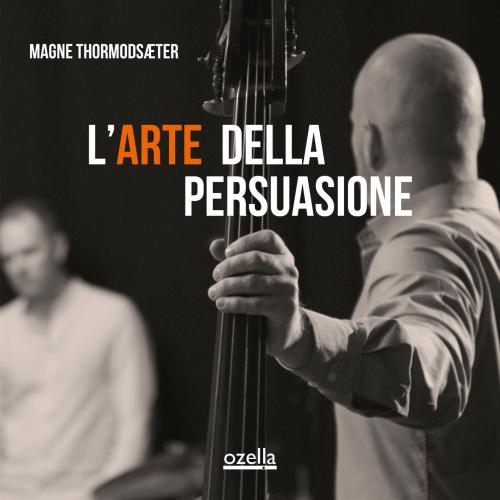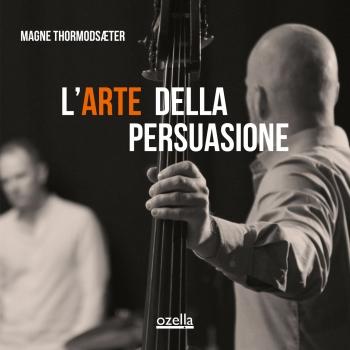
L'arte della persuasione Magne Thormodsæter
Album info
Album-Release:
2024
HRA-Release:
17.05.2024
Label: Ozella
Genre: Jazz
Subgenre: Crossover Jazz
Artist: Magne Thormodsæter
Composer: Magne Thormodsæter
Album including Album cover Booklet (PDF)
- 1 Inventio 07:04
- 2 Dispositio 08:44
- 3 Elocutio 05:58
- 4 Memoria 07:09
- 5 Intermission (Bass Solo) 04:13
- 6 Actio 05:51
Info for L'arte della persuasione
"Two worlds become one: Classical and jazz blend with a beautiful blow."
Magne Thormodsæter is an ECM-alumni, bassist, and in- demand session musician. On L’arte della persuasione, he fuses two worlds with the full force of a beautiful blow. A 35- minute story told in five acts, it pits a high-caliber classical ensemble against a jazz group. The result is captivatingly unclassifiable.
Although Thormodsæter fully composed L’arte della persuasione, the score also provides the musicians with permissions to act spontaneously. The work will thus never sound the exact same way twice. This inner tension was amplified by the process: All musicians only saw the piece on the day of recording.
“I honestly didn’t know what would happen,” Thormodsæter admits, but the result ended up sounding entirely organic. Gradually, the players turned into creators themselves – making the piece “their own.”
To many, the worlds of jazz and classical music may be parallel lines, but they don’t ever converge. Magne Thormodsæter’s aptly titled L’arte della persuasione is quite literally an attempt to convince you otherwise. A 35-minute story told in five acts; it pits a high-caliber classical ensemble against a jazz group to observe the outcome. The result is captivatingly unclassifiable. As much a compositional tour de force as an experiment with uncertain outcome, ECM-alumni, bassist, and in-demand session musician Thormodsæter has created a magical fusion defying the laws of theoretical gravity.
It was a kind of magic which came with a distinct danger of derailing. “I put musicians from these two worlds together in one room and made them play the score for the first time right there,” Thormodsæter recounts from his studio at Bergen university, where he now teaches as a professor, “We instructed the strings with classical terms, and then trusted the ears of the jazz musicians to work things out in the moment. I honestly didn’t know what would happen.” He pauses for a moment. “It did make me quite nervous.”
Although Thormodsæter fully composed L’arte della persuasione, its approach spans a bridge between compositional and improvisational aspects. On the one hand, it takes in the harmonic and melodic language of the written Western tradition. At the same time, at different points, the score provides the musicians with cues – or permissions – to act spontaneously, in close conjunction with the leader of that particular section. The work thus has a modular component to it and will never sound the exact same way twice.
Favouring invention and discovery, the base of the music is simple: people meet, things happen. This, too, is what happened during the sessions. Gradually, the musicians began moving towards each other, overcoming their initial reservations. It forced the classical performers to leave the score behind at times and the jazz musicians to stick to it closer than ever before. As the process intensified, they turned into creators themselves, sculpting the shape of the piece in the moment. They were truly making it “their own.”
“When we started out as students at university, we would constantly have these discussions between classical and jazz students about who held the claim to the highest art,” Thormodsæter remembers, “It was really silly if I think back on it.” To him, the current trend towards unity and border-crossing is as exciting as it is a logical continuation of the deconstructions by Stravinsky and Miles Davis’s later work – which his own music acknowledges as much as it references Bach.
An explorative work, L’arte della persuasione nonetheless feels entirely organic. Maybe that’s because the forces of gravity have been bending the parallel lines of classical and jazz for over a century. Here, they are finally converging with the full force of a beautiful blow.
Melina Mandozzi, violine
Vladimíra Ščigulinská, violin
Mara Haugen, violin
Ricardo Odriozola, viola
John Ehde, cello
Magne Thormodsæter, bass
Eivind Lønning, trumpet
Kjetil Møster, tenor saxophone
Thomas Dahl, guitar
Svein Olav Herstad, piano
Håkon Mjåset Johansen, drums
Ivar Thormodsæter, drums
Magne Thormodsæter
is an award winning Norwegian jazz musician and composer, and one of Norway´s most popular bass players. He is known from a high number of national and international bands and recordings, and collaborations with musicians such as Terje Rypdal, Hildegunn Øiseth, Paolo Vinaccia and Karin Krog, to mention a few.
Magne has his musical degree from the acknowledged jazz education program at NTNU (Norwegian University of Science and Technology) in Trondheim in 1998, and has lived and worked in Bergen after completing his studies. Magne has composed, directed and arranged for many different ensembles, and received the Vossa Jazz Award in 2004 for his work with his own band, Bungalow. Thormodsæter has participated on over 100 recordings and albums throughout his career, and he is a desired musician in both national and international jazz collaborations. Some of his projects during the last few years have been with groups such as Svein Olav Herstad trio, Eivind Austad trio, Hildegunn Øiseth Quartet, Frøydis Grorud kvartett, Way Out West, Nduduzo Makhathini, Karl-Martin Almqvist, among others. He also works as Associate Professor at the Grieg Academy of Music in Bergen.
Booklet for L'arte della persuasione










